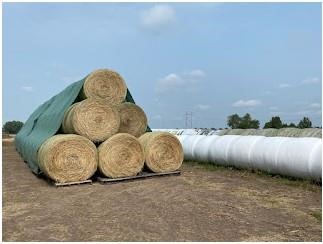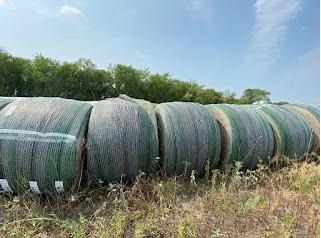By Jared Goplen and Nathan Drewitz
Alot of time and energy is spent harvesting quality hay and silage. Up to 50% losses in dry matter can occur in some instances for hay and silage. This is the equivalent of leaving half of your acres unharvested! Losses up to 20% can occur without even noticing. In a year when forage supplies are already tight, don’t make matters worse by poorly storing forage.
Key Points
- Hay storage losses are often related to contact with too much moisture.
- Silage losses are often due to exposure to oxygen during storage and feed out.
- Taking precautions now can help minimize storage and feeding losses, helping your hard-earned forage supplies last longer.
Minimize hay losses
To minimize your hay storage losses, do everything you can to keep hay dry. Even small changes can have large impacts on hay storage losses, forage quality, and profitability:
- Make dense bales of dry (<20%) hay (lower moisture for larger bales).
- Stack hay so it does not trap moisture.
- Improve drainage of your hay storage pad.
- Consider buildings, tarps or bale wraps to keep hay covered.
Prevent moisture contact
Hay has the same enemy in the field as it does in storage — moisture. Preventing moisture contact with bales should be your top priority. Moisture enters hay from the top and bottom, coming from precipitation, as well as wicking from the soil. Keeping hay off the ground and under a covering structure prevents the majority of moisture problems (Photo 1).

Photo 1. Round hay bales stored using various
methods. Note the covered pyramid elevated on
pallets with both wrapped and covered bales
in the background.
Hay properly stored should only lose 2-5% of dry matter over several years of storage. If hay gets wet, however, microbes come to life. Those microbes start eating away at the hay, which leads to losses in dry matter and deterioration in quality. The simultaneous loss of both dry matter and forage quality decreases hay value. In just 8 months, losses in forage quality can easily reduce hay value by more than $30 per ton.
Evaluate the ground where hay is stored
If you are storing hay on poorly drained soil such as sod or black soil, water will wick up from the ground. Hay that is dry at harvest can increase to over 30% moisture through wicking. This level of moisture can cause spoilage and dry matter losses over 20%, even over a short period of time. Losses may approach 50% if stored for more than one year.
- Store hay on a well-drained surface such as gravel, rock, or old tires or pallets to keep hay out of contact with the soil to minimize dry matter losses to less than 15%.
Round vs. square bales
If hay must be stored outside, several small changes can minimize storage losses.
- Square bales will be fine outside if bales are covered and elevated off the ground.
- Tightly wrapped round bales are a better option when left uncovered, as they form a thatch layer and shed water best.
- Net-wrapping improves the ability for round bales to shed moisture, resulting in 32% less dry matter losses compared to twine bales. If twine is used, spacing it less than 6 inches apart will improve the bale’s ability to shed water.
Bale size
Making larger bales means a greater percentage of the hay is protected inside the bale. The outer several inches of a bale tend to have the greatest spoilage, meaning larger bales help minimize storage losses outdoors.
- The outer 2 inches of a 4- foot bale contains 16% of the bale’s dry matter, while just 11% of dry matter is contained in the outer 2 inches of a 6-foot bale.
Stacking method
Avoid stacking bales in an orientation that traps moisture between bales.
- Uncovered bales should never be stacked in a pyramid, as this stacking method traps the most moisture and causes the largest dry matter losses.
- End to end stacking, so bale ends are touching, is the best choice for outdoor bale storage. 3-5 feet should be left between rows of bales to allow water a place to go and air movement between the bales.
- DO NOT let rows of bales touch each other
- A north - south orientation of bales is best, as it permits more uniform sunlight to reach bales.
Cover bales to maintain quality
If you need to preserve high quality hay and have little tolerance for losses, consider covering bales stored outside. Depending on the quality of hay, it could be well-worth the hassle and extra work of covering hay outside with plastic or tarps.
- Covering bales can reduce dry matter losses by an additional 6% or more compared to storing on a well-drained pad.
- Consider a bale-covering technology such as bale sleeves or bale wraps, which can minimize losses so they are more similar to that of indoor storage. Click here for a UMN research summary on various bale wrapping technologies.
- Consider wrapping hay as baleage rather than storing as dry hay. Baleage can help minimize harvesting and storage losses. Individual and in-line bale wrappers have also been used successfully in storing dry hay.

Photo 2. Round hay bales stored with B-Wrap®
(Ambraco Inc.), a breathable bale covering that
improves the ability for bales to shed moisture,
preserve dry matter, and maintain quality better
than unprotected bales.
Table 1. Effect of storage method on hay storage dry matter losses.
| Hay storage method | Dry matter loss range |
|---|
| | % |
| Under roof | 2-10 |
| Plastic wrap, on ground | 4-7 |
| Bale sleeve, on ground | 4-8 |
| Covered, rock pad or elevated | 2-17 |
| Uncovered, rock pad or elevated | 3-46 |
| Uncovered, on ground, net wrap | 6-25 |
| Covered, on ground | 4-46 |
| Uncovered, on ground | 5-61 |
From Craig Saxe, 2007, UW, Big Bale Storage Losses; how different options stack up.
Minimize silage losses
To minimize silage storage losses, limit the exposure of stored silage to oxygen. Oxygen allows microbes to metabolize dry matter and affects forage quality. Every effort to limit oxygen exposure will decrease losses and enhance quality and profitability:
- Ensure proper moisture and packing density at harvest.
- Exclude oxygen from storage structures.
- Ensure adequate feed out rates and good silo face management to prevent spoilage at feed out.
Maintain tower silos and bunkers
Check and maintain walls, doors, and ceilings of silos regularly to help minimize air exchange and keep precipitation from entering the silo through cracks in concrete and around doors. Spoilage in your silo that steadily worsens from year to year, especially around doors and walls, indicates that maintenance is needed. Even if cracks are not visible, silo maintenance may still be needed.
Maintain plastic
Silo bags, bunkers and piles all rely on plastic to exclude air and precipitation from the silage. Punctures in this plastic can be caused by people, animals, equipment, and weather. Punctures will let air and water in, causing losses. To help prevent these losses, take the following measures:
- Seal plastic coverings tightly to the silage surface.
- Slope appropriately to drain water away from entry points into the silage.
- Store silage bags away from areas that increase the likelihood of punctures.
- Inspect bags and coverings periodically and repair holes with oxygen-excluding tape.
Proper Feed Out
Feed out losses can be as much as 15% depending on management and the storage structure used. To minimize losses at feed out, it is important to minimize air exposure and to feed out fast enough to keep fresh silage exposed. Losses can be minimized by feeding out 4” per day from tower silos, 6” per day from bunkers and piles, and 12” per day from silage bags. Silage with lower densities (<13 lb/ft3) will require faster feed out to minimize spoilage. If you can’t feed out fast enough for your storage structure, consider alternatives. Other proper feed out management practices to follow include:
- Keep smooth, undisturbed surfaces exposed on silage piles and bags to minimize air exposure.
- Roll back silage covers on bunkers and piles for no more than 3 days of feeding at a time and keep plastic sealed to the silage surface to avoid air penetration.
- Avoid accumulated piles at the base of the feed out face as these piles will deteriorate faster.
- Place silo bags, bunkers and piles on a surface that allows for effective feed removal without having to operate in muddy conditions.
Table 1. Estimated range of dry matter storage losses under "ideal" moisture conditions for different storage structures. Losses will be greater at higher or lower moisture contents than the optimum storage moisture. These estimated ranges include potential losses during filling, storage and feed out.
| Silo type | Moisture content | Dry matter loss |
|---|
| | % | % |
| Upright silo | 60-65 | 11-19 |
| Oxygen-limiting silo | 50-60 | 6-12 |
| Trench or bunker (covered) | 65-701 | 16-23 |
| Silage bags | 60-701 | 9-14 |
1Avoid ensiling crops above 70% moisture in structures to prevent clostridial fermentation.
Adapted from Holmes and Much, 2000. Preventing Silage Storage Losses.
Source : umn.edu